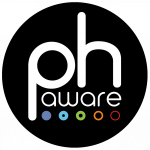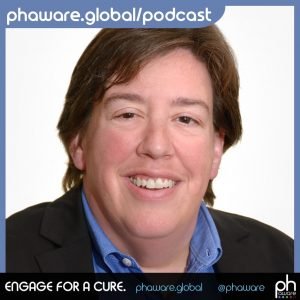Phaware Podcast: Liz Klings, MD

This podcast series, created and produced by phaware, is being offered as a regular guest feature on Pulmonary Hypertension News to bring the voices and life experiences of PH patients, family members, caregivers, healthcare specialists, and others to our readers. You may listen to the podcast directly, or read it via the transcript that runs below.
I’m Aware That I’m Rare: Liz Klings, MD
The phaware™ interview
Dr. Elizabeth Klings is an Associate Professor of Medicine and the Director of the Center for Excellence in Sickle Cell Disease at Boston University School of Medicine. Her clinical and research interests have focused on the pulmonary vascular complications of sickle cell disease, and she has published over 40 papers and book chapters on the subject. She led the development of the Clinical Guidelines for the Diagnosis and Treatment of Pulmonary Hypertension in Sickle Cell Disease published in the American Journal of Respiratory and Critical Care Medicine in 2014 and is now pursuing research to advance our understanding of this complication of the disease.
My name is Dr. Liz Klings. I am an associate professor of medicine at Boston University School of Medicine, director of the Center for  Excellence in Sickle Cell Disease there, and I also am a member of the Pulmonary Hypertension Center at Boston University and Boston Medical Center.
Excellence in Sickle Cell Disease there, and I also am a member of the Pulmonary Hypertension Center at Boston University and Boston Medical Center.
Today, I’d like to talk to you about sickle cell disease and how it relates to pulmonary hypertension.
So, sickle cell is a genetic disease. So it’s inherited, and in order to inherit the disease, you need to obtain, you need to have one gene from your mother and one gene from your father. It is something that’s called autosomal recessive in the way that it’s inherited. The gene that’s involved is a gene called hemoglobin S.
Patients who have sickle cell disease have either two of the hemoglobin S genes or they have one hemoglobin S gene and a gene for another abnormal hemoglobin such as hemoglobin C or hemoglobin beta thalassemia.
Kids who are affected with this will be actually diagnosed in the United States at birth [with] screening and newborn diagnostic testing. They may start to develop problems during childhood, and most frequently, patients get admitted to the hospital during childhood for what’s called the vaso-occlusive crisis, or painful crisis, but then there were other complications that can happen as well in different organs, such as strokes. Certain people can get problems with their kidneys over time. There were diseases that can happen to the bones and joints, something that’s called the avascular necrosis, and then there are different complications that can happen within the heart and lungs.
Pulmonary hypertension is one of these types of complications that can happen to patients with sickle cell disease. We find that it happens more commonly as people get older and older, as sickle cell disease is over the age of 30 or 35. So it may not be what people in the general population think of as being older. So, we know that if about 100 people with sickle cell disease were in a room, somewhere between six to 11 of them would have pulmonary hypertension.
Three years ago now, the American Thoracic Society published guidelines for the diagnosis and treatment of pulmonary hypertension related to sickle cell disease, which I was very heavily involved with and was the first author on. And what we recommend for adults, so anybody over the age of 18 with sickle cell disease, is that they obtain an echocardiogram as an ultrasound test of the heart at least once every couple of years to evaluate for the possible presence of pulmonary hypertension. And that’s one of the ways to try to screen people for the presence of the disease.
The other thing to be aware of is that there are symptoms that may suggest pulmonary hypertension, such as increased shortness of breath, pain or pressure in your chest, or worsening dizziness, or passing out with exertion. People with sickle cell disease may have some of these symptoms and it may not relate to pulmonary hypertension at all. We know that just being anemic, related to sickle cell disease can cause some of these symptoms as well. And it’s one of the reasons that we advocate for doing echocardiograms in everyone, to try to identify who may have pulmonary hypertension.
So first of all, you need to realize that sickle cell disease is an international problem. It isn’t just limited to the United States. While 100,000 individuals are living with sickle cell disease in the United States of America, there are about 250,000 births that occur each year worldwide. The majority of patients with sickle cell disease are being born in Sub-Saharan Africa and India. Many of those patients don’t live to adulthood because of complications of their disease. But what I will say is that the scope of potential patients that may be affected with pulmonary hypertension is actually quite large, and that’s one of the reasons to try to increase awareness of this disease. Because the frequency of adults who are affected with the disease is similar to scleroderma, another rare disease but with a fairly common incidence of pulmonary hypertension within it.
One of the things that came out of the guidelines and the work that’s followed is that there are still many unanswered questions in the area of pulmonary hypertension related to sickle cell disease. And one of the reasons that is, is that this is a rare complication of a rare disease. That is a challenge for us in terms of how to answer the questions facing this disease. So what we know of the disease frequency is that if you obtain echocardiogram on adults with sickle cell disease, particularly if they have hemoglobin SS disease, about a third of adults will have abnormal echocardiogram suggestive of pulmonary hypertension.
But only about 6% to 11% of the adults actually truly have pulmonary hypertension, and it is necessary and essential for anybody who is suspected of having pulmonary hypertension to undergo a right heart or pulmonary artery catheterization to actually diagnose the disease. That was one of the things that came out of the guidelines from a couple of years ago.
The other thing that remains an unanswered question is once you have pulmonary hypertension, where to go from there? What we know about pulmonary hypertension and sickle cell disease is not everybody who has PH actually has pulmonary arterial hypertension. At least half of the people with pulmonary hypertension have elevated pulmonary pressures related to problems with the left side of their heart. It’s not clear at this point if those patients should be treated the same as patients who have pulmonary arterial hypertension.
The other thing that we don’t completely understand is whether or not patients who have pulmonary hypertension related to sickle cell disease will respond the same way to traditional pulmonary hypertension treatments. And there’s a lot of interest in this community in really trying to investigate that more intensely. What has been clear from the randomized control trials that have been attempted in this population is that pulmonary hypertension in many ways is different when it affects patients with sickle cell disease than in the general population, and the sickle cell disease is always playing a role in the disease process. So you can’t just focus on the PH. You have to also treat the sickle cell disease in these patients.
There’s an important need to look for other complications such as pulmonary emboli and thromboses or blood clots within the lungs, which likely occur more commonly in patients with sickle cell disease and likely make pulmonary hypertension worse. There’s also a need to look for hypoxia or low oxygen levels from this population, as well, that may occur at either sleep or with exercise, because that would be another important target of treatment. So, I think one of the big questions that remains, even though we wrote a guidelines document three years ago, is how we should be treating patients with pulmonary hypertension.
From my clinical experience, patients who have hemodynamics or hemodynamic numbers that are consistent with pulmonary arterial hypertension, those patients do actually respond well to medications that treat other types of patients with pulmonary hypertension. Many of us in the field will treat our patients with these medications if they meet those qualifications. But I think it really is important for patients with sickle cell disease and pulmonary hypertension to be treated at a center where there is expertise in both aspects of their disease, the pulmonary hypertension piece as well as the sickle cell disease piece, because there really is, … It is necessary for sort of a multidisciplinary treatment plan to exist.
I’m Dr. Liz Klings, and I’m aware that I’m rare.
EVERYBODY HAS A STORY. WHAT’S YOURS?
phaware wants to share your pulmonary hypertension story with their engaged global audience. Whether you are a patient, caregiver, or medical professional, they are enlisting PH community members from across the globe. Visit www.phaware.global/podcast to share your story and to be considered for a future episode.And learn more about pulmonary hypertension at www.phaware.global. #phaware #phawarepod
***
Note: Pulmonary Hypertension News is strictly a news and information website about the disease. It does not provide medical advice, diagnosis, or treatment. This content is not intended to be a substitute for professional medical advice, diagnosis, or treatment. Always seek the advice of your physician or other qualified health provider with any questions you may have regarding a medical condition. Never disregard professional medical advice or delay in seeking it because of something you have read on this website. The opinions expressed in this column are not those of Pulmonary Hypertension News or its parent company, Bionews Services, and are intended to spark discussion about issues pertaining to pulmonary hypertension.










Leave a comment
Fill in the required fields to post. Your email address will not be published.